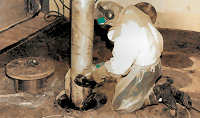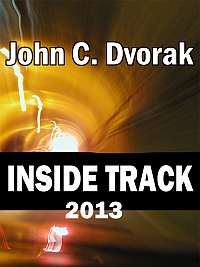
Read the whole story for a fascinating, blow by blow account of how a nucular (as Geo. W. would say it) plant nearly melted down.
In the wake of World War 2 the United States government enacted legislation which prohibited any other nations from receiving the scientific bounty derived from the Manhattan Project. This meant that despite the participation of British scientists in the project, Britain received none of the benefits of the research. The year after the United States’ first successful nuclear bomb test in July of 1945, the British government decided that they too must develop a nuclear program in order to maintain their position as a world power. This pilot project eventually developed into the Windscale Nuclear plant.
In October 1957, after several years of successful operation, the workers at Windscale noticed some curious readings from their temperature monitoring equipment as they carried out standard maintenance. The reactor temperature was slowly rising during a time that they expected it to be falling. The remote detection equipment seemed to be malfunctioning, so two plant workers donned protective equipment and hiked to the reactor to inspect it in person. When they arrived, they were alarmed to discover that the interior of the uranium-filled reactor was ablaze.
As one of the men battling the unique fire described the exposed fuel channels, “It was white hot, it was just white hot. Nobody, I mean, nobody, can believe how hot it could possibly be.”
















Cockcroft’s Folly – interesting read.
Chicken chicken chicken ? Chicken chicken chicken chicken, chicken chicken chicken. Chicken chicken chicken chicken chicken; chicken chicken chicken chicken…
#2: ????
The problem is that people always point to those ancient reactor designs when talking about the dangers of nuclear power.
When I went through the Navy’s nuclear power school and onto a fast-attack sub in the mid-1960s, we saw some of the industrial designs then being built. They were texts on how NOT to build a safe reactor. Admiral Rickover, whatever his other faults, was adamant about reactor operating safety, redundant systems, backup systems, manual overrides and a host of other basic design elements on his submarines. We considered the commercial designs, designed for efficiency rather than safety or reliability, accidents waiting to happen. SmartAlix is right – designs have no doubt advanced a lot since those days, in terms of safety and reliabiilty.
Of course that still doesn’t answer questions about how to store away the resulting nuclear garbage or prevent political or religious fanatics (other than our own president, I mean) from misusing it.
I think this is the punchline of the article:
“Ultimately the unnecessary incident could have been avoided with a bit of knowledge from the Manhattan project. Had the American government opted to share the nuclear knowledge which the British had helped to gain, the mishap could have been avoided altogether.”
4,
Find 1 Nuclear plant that was built AFTER the 60’s.
Find 1, that some contractor didnt Substitute Poor materials on.
TRY to find, the records of mishaps from those plants, NOT the news worthy ones that caused Shut downs.
Find 1 that has been upgraded from the Past to NEWER better tech.
Find 1 that goes thru FULL shut down testing, so that it can TEST all procedures and mechanical shutdowns that MAY have rusted shut/open in the last 40 years.
Find any Public records on maintenance schedules and Building updates and repairs.
Then find me the storage location for all the Empty fuel rods, sence Nevada STILL isnt ready after 20+ years.
3…..
Chicken, Chicke chicken??
Translation:
Baaa, baa baa…
Translation:
Running gag from Blog.
I know, too late to post. But the NRC actually does a good job of keeping our nuclear power plants safe.
3MI was a a fluke. We’ve come a long way in tech since then.
I’ve a friend that works at a nuclear facility in the US (not high-level mgmt.), and just friend-to-friend, no classified material here, his remarks indicate the NRC does a remarkable job.
I’d rather we decide how to get rid of the minimal waste from all the nukes in the U.S. than figure out how to clean up after the darned coal-fired power plants, their strip mining and the govt. jerks in their pockets.
http://www.nrc.gov/
While this story is about British problems, every country that developed nuclear energy had some teething problems. Many of these countries still get much of their energy from nuclear reactors. And many of these countries also had some scientists contributing to the Manhattan Project.
This is hardly a unique story. The plant in the list is maybe 6 miles from the high school I attended, and I could see the cooling towers from the roof of my house.
FWIW it looks like the eco-freaks are finally coming around…nuke power is the only way we sustain ourselves on this planet, and on balance it is by far the cleanest way.
Um, make that “the plant in the link.”
I work about a half mile from a nuke plant. Certainly doesn’t cause me any stress. We need to build more of them and should have started construction 10 years ago.
Okay all you people in favor of nuclear power, answer me this.
What do we do with the highly toxic, radioactive waste that has a half-life of several thousand years? How can we keep it from getting into the wrong hands for several tens of thousands of years?
Nuclear power is fine, until you look at the waste disposal aspect, which is a point its advocates ignore.
Nuke waste is a simple problem once we get past the hype and fear, especially the political fear. IMO, encapsulate it and drop it into a deep ocean trench.
The thing is, coal is such a horrible fuel. Your got black lung disease, destroyed environments, and all of it ends up in our air. Lots of people die every year from coal. Anything would be better.
“Nuke waste is a simple problem once we get past the hype and fear, especially the political fear. IMO, encapsulate it and drop it into a deep ocean trench.”
The problem with that is that a deep ocean trench is a tectonically active area. What impervious material do you pose we ‘encapsulate’ it in?
Personally, I would hate to see the consequences if this is done, the ‘encapsulation’ comes apart, and there is an earthquake on one of these trenches, and >BOOM
OMG.
Ya see, Roc, that’s the hype I was specifically referring to. Nuke waste is inert except for the gamma rays. Spent rods are just as likely to explode as your dog is likely to spontaneously combust in your yard after taking a dump.
So there’s an earthquake down there. Big deal…what’s going to happen? The rods drop even further into the earth. That’s bad how? Maybe they get spread out. There’s still four miles of seawater between them and the surface, and no easy way to get there. Hell, the earth is already filled with uranium. That hasn’t killed us, has it?
And I’m not talking about big giant containers. Wrap the rods in steel, lead, PVC, used rubbers, whatever. Nothing decomposes or rusts at the bottom of the ocean. Hell, just drop them in unprotected…what’s the diff? Anyone going to notice a couple square miles of dead ocean floor? Whatever does live there we can study.
It somehow bothers me that throwing it into the ocean is the standard way of getting rid of dangerous things.
Too bad we can’t guarantee a successful rocket launch every time. We could send the spent rods into the Sun and forget ’em. The folks who figure out how to recycle the stuff will make billions.
I saw a really interesting doccumentary on the cleanup of the chernobyl disaster – cant remember the title, was REALLY interesting tho – especially because the video has that grainy quality generally attributed to nuclear particles bombarding the filmstock.
Methods have been proven to get rid of the nuclear waste.
The browns gas generator/welder for one.
Our Big welfare waste companies would be out of work if they
had not stopped its use.
Think of all the Billions spent, such a tragedy.